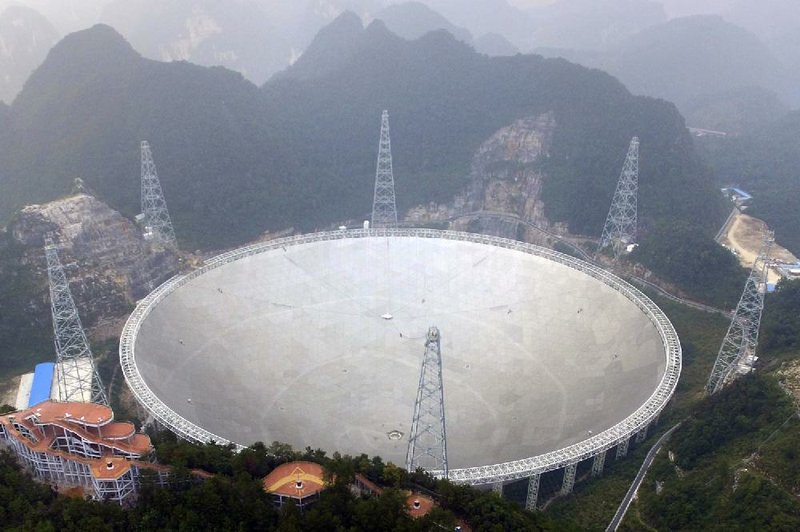BEIJING -- The world's largest radio telescope began searching for signals from stars and galaxies Sunday in a project demonstrating China's rising ambitions in space and its pursuit of international scientific prestige.
Beijing has poured billions of dollars into such ambitious scientific projects as well as its military-backed space program, which earlier this month saw the launch of China's second space station.
Measuring about 546 yards in diameter, the radio telescope is nestled in a natural basin within a landscape of lush green karst formations in the southern Guizhou province. It took five years and $180 million to complete, and it surpasses the 330-yard Arecibo Observatory in Puerto Rico, a dish used in research on stars that led to a Nobel Prize.
The official Xinhua News Agency said hundreds of astronomers and enthusiasts watched the launch of the Five-hundred-meter Aperture Spherical Telescope, or FAST, in the county of Pingtang.
Researchers, quoted by state media, said the telescope would search for gravitational waves, detect radio emissions from stars and galaxies and listen for signs of intelligent extraterrestrial life.
"The ultimate goal of FAST is to discover the laws of the development of the universe," Qian Lei, an associate researcher with the National Astronomical Observatories of the Chinese Academy of Sciences, told state broadcaster CCTV.
"In theory, if there is civilization in outer space, the radio signal it sends will be similar to the signal we can receive when a pulsar [a spinning neutron star] is approaching us," Qian said.
The dish is made of 4,450 intricately positioned triangular panels and has a collecting area of 2.1 million square feet, equal to almost 450 basketball courts.
Installation of the structure -- nicknamed Tianyan, or the Eye of Heaven -- started in 2011 and was completed in July.
The telescope requires a radio silence within a 3-mile radius, resulting in the relocation of more than 8,000 people from their homes in eight villages to make way for the facility, state media said. Reports in August said the villagers would be compensated with cash or new homes from a budget of about $269 million from a poverty relief fund and bank loans.
Not all of the thousands of people being moved for the telescope want to go.
"I've lived here all my life. My ancestors arrived here in the Qing dynasty over 200 years ago," said Huang Zhangrong, a 66-year-old carpenter from Miaoping village. "We don't want to leave, but the government says it's for the good of the country."
Scientists say the telescope, and the spending to relocate eight villages, show that China is willing to spend heavily on research that offers few direct payoffs, apart from knowledge and prestige.
"Astronomy is an ultimate expression of 'pure' science that has little immediate practical benefits," Luis Ho, director of the Kavli Institute for Astronomy and Astrophysics at Peking University, said by email. "It is a luxury that only the most advanced economies enjoy."
CCTV reported that during a recent test, the telescope received radio signals from a pulsar that was 1,351 light-years from Earth.
The radio telescope has double the sensitivity of the Arecibo Observatory, and five to 10 times the surveying speed, Xinhua said.
China has also completed the construction of tourist facilities, such as an observation deck on a nearby mountain, reports said. Such facilities can be a draw for visitors -- the one in Puerto Rico draws about 90,000 visitors and some 200 scientists each year.
The telescope will help China make "major advances and breakthroughs at the frontier of science," Chinese President Xi Jinping said in a congratulatory message Sunday. He called it China's "eye in the sky."
Researchers involved in the international effort to search for intelligent life on distant planets will "piggyback" on the telescope's scans to sift for signals, said Dan Werthimer, chief scientist of the Search for Extraterrestrial Intelligence Research Center at the University of California, Berkeley.
"They're very keen to collaborate," he said in a telephone interview. "We can use the telescope at the same time that they're doing more traditional astronomy to look for E.T."
Earlier this month, China launched the Tiangong 2, its second space station and the latest step in its military-backed program that intends to send a mission to Mars in the coming years. In August, the country launched what it said was the first quantum satellite, capable of encrypting data much more heavily than a satellite using binary computing. Experts said it would advance efforts to develop the ability to send communications that can't be penetrated by hackers.
Studying the heavens was an area in which China excelled in ancient times.
"Now we're racing to catch up and want to recreate the glories of our ancestors by reviving our astronomy," Zhang Chengmin, an astrophysicist at the National Astronomical Observatories of the Chinese Academy of Sciences, said in an interview. "China isn't just an economic power; it is also becoming a scientific power."
Information for this article was contributed by Gillian Wong and Henry Hou of The Associated Press and by Chris Buckley and Adam Wu of The New York Times.
A Section on 09/26/2016
